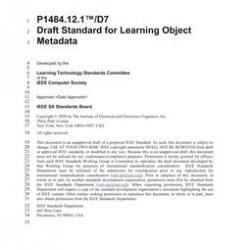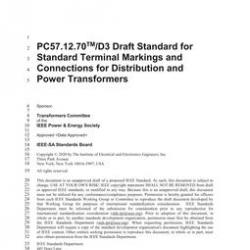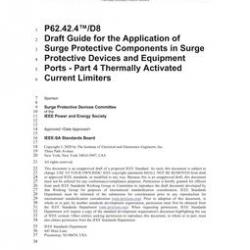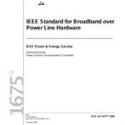Full Description
Scope
This guide provides guidance for using radio frequency (RF) wireless communication technologies for ISO/IEEE 11073 point-of-care (PoC) medical devices that exchange vital signs and other medical device information using shared information technology (IT) infrastructure. Use cases specific to these technologies are evaluated, and key functional and performance criteria are identified, including quality of service (QoS) management, privacy and security, coexistence with other RF wireless technologies, environmental requirements such as electromagnetic interference and compatibility (EMI/EMC), and power management. Guidelines are provided for each of these areas. Technologies include, but are not limited to, the IEEE 802.11 and IEEE 802.15¿¿¿ technologies. Use case environments include traditional clinical settings as well as personal (home and mobile) healthcare. The intent of guide is to be global with respect to wireless spectrum and equipment, although working group participation and expertise have favored detail of scenarios from the United States. Importantly, this guide will not be periodically updated, but instead will act as a source of information for follow-on ISO/IEEE 11073 RF wireless transport standards that will supersede it. These ISO/IEEE 11073 RF wireless transport standards will detail the use of specific wireless networked technology for the purpose of transporting medical data. Periodic updates will be performed on the ISO/IEEE 11073 standards only.
Purpose
In recent years there has been rapid growth of RF technology to support wireless communication and data transport, as evidenced by the growing use of personal communication devices (e.g., mobile phones, WiFi enabled laptop computers). The incorporation of RF technology into PoC medical devices for wireless data transport has the potential to offer significant benefits to healthcare, although there are many issues that need to be understood and managed in order to ensure data transfer to computer servers, healthcare professionals, terminal data collection units, or other medical devices is accurate, efficient and reliable. Specific recommendations are aimed at different stakeholder groups that make up the audience for this guidance document including healthcare providers, medical device manufacturers / vendors, wireless equipment manufacturers / vendors, and relevant agency groups. The different functionality and operating environment of medical devices is addressed, ranging from core hospital equipment providing complex waveform and other physiological data to single parameter, low data rate sensors worn in a mobile health scenario. Further, patients, healthcare workers, medical equipment, and medical data move across different areas of the healthcare topology and necessitate that data track in a seamless and managed manner. Quality of Service (QoS) requirements (e.g., priority, throughput, latency) can vary significantly across different medical data types (e.g., alarms, real time wave forms, chart data, asset tracking, e-prescriptions), and simultaneous transport of different data types on a shared IT infrastructure are considered for the design of appropriate solutions. Other issues associated with operation on standardized "open" networks are security and privacy.Coexistence becomes a significant issue as a growing number of medical devices from multiple manufacturers, perhaps using multiple technologies (e.g., IEEE 802.15.1(tm) with IEEE 802.11b(tm)), start to crowd the RF spectrum and compete for bandwidth and channel access. Other issues considered include EMI/EMC, cost, power consumption, and technology configurability. Several factors influence the performance of the wireless system itself, including whether it operates on a shared IT network (e.g., WLAN, WWAN) or simply maintains a point-to-point connection. The former example is especially important when considering the operation of multiple medical devices from different manufacturers, each with different QoS requirements.An overall effort to promote plug-and-play (PnP) operability between commercially available medical devices and wireless systems (i.e., IEEE, ISO, ANSI, ITU-R, ITU-T), is supported in this guidance document, as well as in follow-on IEEE 11073 profile standards. As private homes are increasingly outfitted with wireless networks, and home- and mobile- management of healthcare and chronic conditions becomes increasingly common, additional issues may emerge.Recommendations provided in this document are not prescriptive, but instead offer general guidance aimed at the different stakeholders to facilitate design and management of wireless medical data transport to support the necessary QoS and performance requirements as well as co-exist in a complex environment with other wireless traffic. Likewise, exercises and comparisons included in this document are not intended to endorse any particular medical device, wireless technology, or data exchange format, but to offer examples for reference and comparison. Ultimate solutions will vary greatly depend greatly on healthcare needs, resources, sizes, and environments.
Abstract
New IEEE Standard - Inactive-Reserved."The following Guidance document addresses the use of radio frequency 1 (RF) wireless technology for the transport of medical data both to and from point-of-care (PoC) medical devices. The context of such wireless medical data transport can range from home- or mobile-based healthcare to in hospital ambulatory and stationary situations. The intent of the guidance document is to be global with respect to wireless spectrum and equipment, although working group participation and expertise have favored detail of scenarios from the US. At the time of this Guidance document several applicable RF wireless technologies exist with a range of capabilities and characteristics, and in different stages of maturity, standardization, and adoption in healthcare. It is recognized that RF technologies are rapidly evolving, and new options may become available (or sufficiently established) after the publication of this Guidance document. The recommendations, therefore, avoid being overly prescriptive and instead attempt to assist medical device manufacturers, wireless equipment manufacturers, healthcare providers, government agencies and any other end-user of this document to make reasonable judgments regarding performance and practical implementation of wireless solutions. The Guidance document defines specific use cases to estimate, compare, and contrast performance of known technologies operating on wireless personal area (WPAN), wireless local area (WLAN), wireless metropolitan area (WMAN), and wireless wide area (WWAN) networks. Major considerations are 1) the quality-of-service (QoS) requirements (reliability, latency, priority, bandwidth) associated with the data being transported, 2) the expected performance (power, link range, throughput, link establishment and maintenance) of the wireless technology, and 3) the specific needs and resources of the end user. Related issues include network architecture, EMI/EMC, coexistence with other data streams, security, cost, power consumption, and technology configurability. Performance summaries for specific wireless technologies that support defined use cases are not intended as an endorsement of optimal solution because different needs, resources, sizes, and environments cannot be comprehensively addressed. This overview document is meant to be a foundation and reference for several follow-on IEEE 11073.3.5.x standards that will profile specific classes of off-the-shelf RF wireless technologies for medical data transport. Importantly, this guidance document is not envisioned to be periodically updated, but instead will act as a source of information for the follow-on IEEE 11073-0305.x standards that will supplant it. Periodic updates will be performed on the IEEE 11073- 0305.x standards only."


































